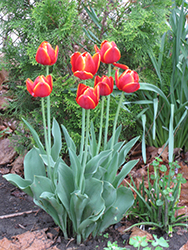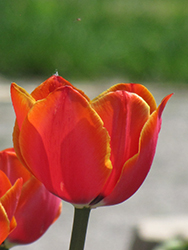It's all about ...
plants

World's Favorite Tulip
Tulipa 'World's Favorite'
Height: 24 inches
Spacing: 6 inches
Sunlight:
![]()
Hardiness Zone: 3a
Group/Class: Darwin Tulip
Description:
A fun and well loved variety, featuring large, scarlet-orange blooms edged in golden yellow; blooms mid to late season, perfect for spring garden beds and borders; strong, sturdy stems dance in the breeze without breaking; excellent cut flower quality
Ornamental Features
World's Favorite Tulip has masses of beautiful scarlet cup-shaped flowers with yellow eyes and yellow edges at the ends of the stems in late spring, which are most effective when planted in groupings. The flowers are excellent for cutting. Its sword-like leaves remain green in colour throughout the season.
Landscape Attributes
World's Favorite Tulip is an herbaceous perennial with tall flower stalks held atop a low mound of foliage. Its medium texture blends into the garden, but can always be balanced by a couple of finer or coarser plants for an effective composition.
This is a relatively low maintenance plant, and should not require much pruning, except when necessary, such as to remove dieback. It has no significant negative characteristics.
World's Favorite Tulip is recommended for the following landscape applications;
- Mass Planting
- General Garden Use
Planting & Growing
World's Favorite Tulip will grow to be about 20 inches tall at maturity, with a spread of 6 inches. When grown in masses or used as a bedding plant, individual plants should be spaced approximately 6 inches apart. It grows at a medium rate, and under ideal conditions can be expected to live for approximately 10 years. As an herbaceous perennial, this plant will usually die back to the crown each winter, and will regrow from the base each spring. Be careful not to disturb the crown in late winter when it may not be readily seen! As this plant tends to go dormant in summer, it is best interplanted with late-season bloomers to hide the dying foliage.
This plant should only be grown in full sunlight. It does best in average to evenly moist conditions, but will not tolerate standing water. This plant should not require much in the way of fertilizing once established, although it may appreciate a shot of general-purpose fertilizer from time to time early in the growing season. It is not particular as to soil type or pH. It is highly tolerant of urban pollution and will even thrive in inner city environments. This particular variety is an interspecific hybrid. It can be propagated by multiplication of the underground bulbs; however, as a cultivated variety, be aware that it may be subject to certain restrictions or prohibitions on propagation.


